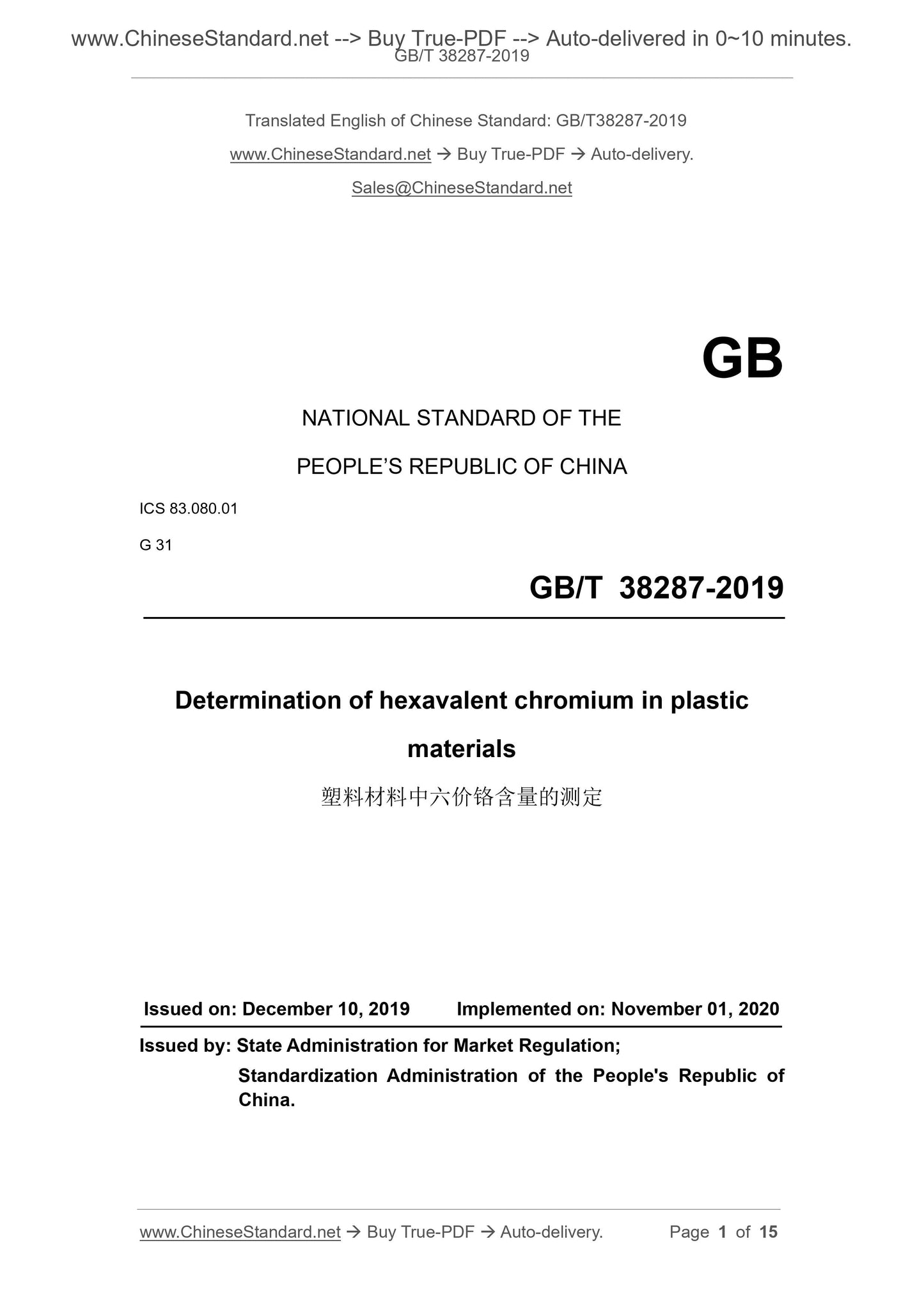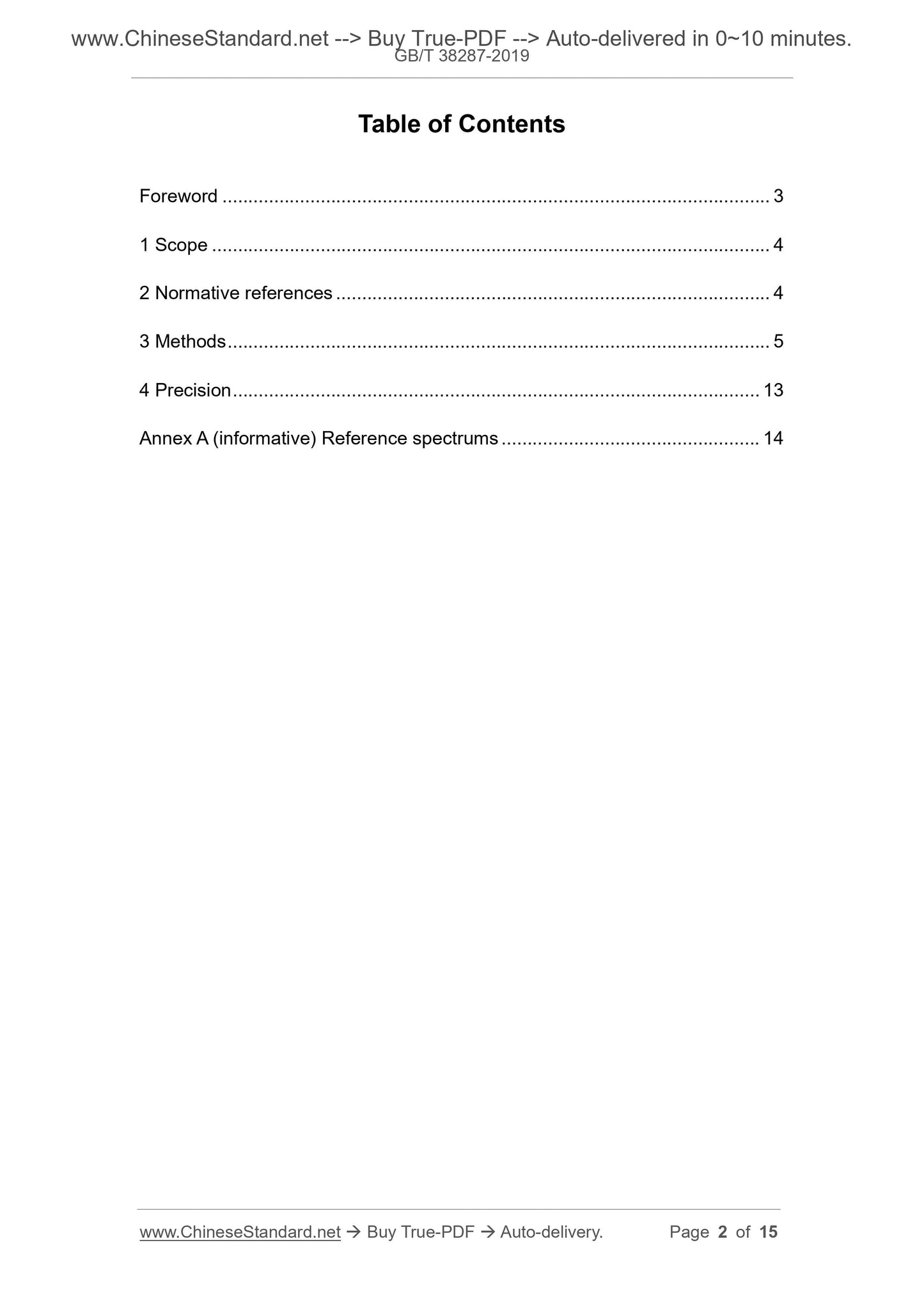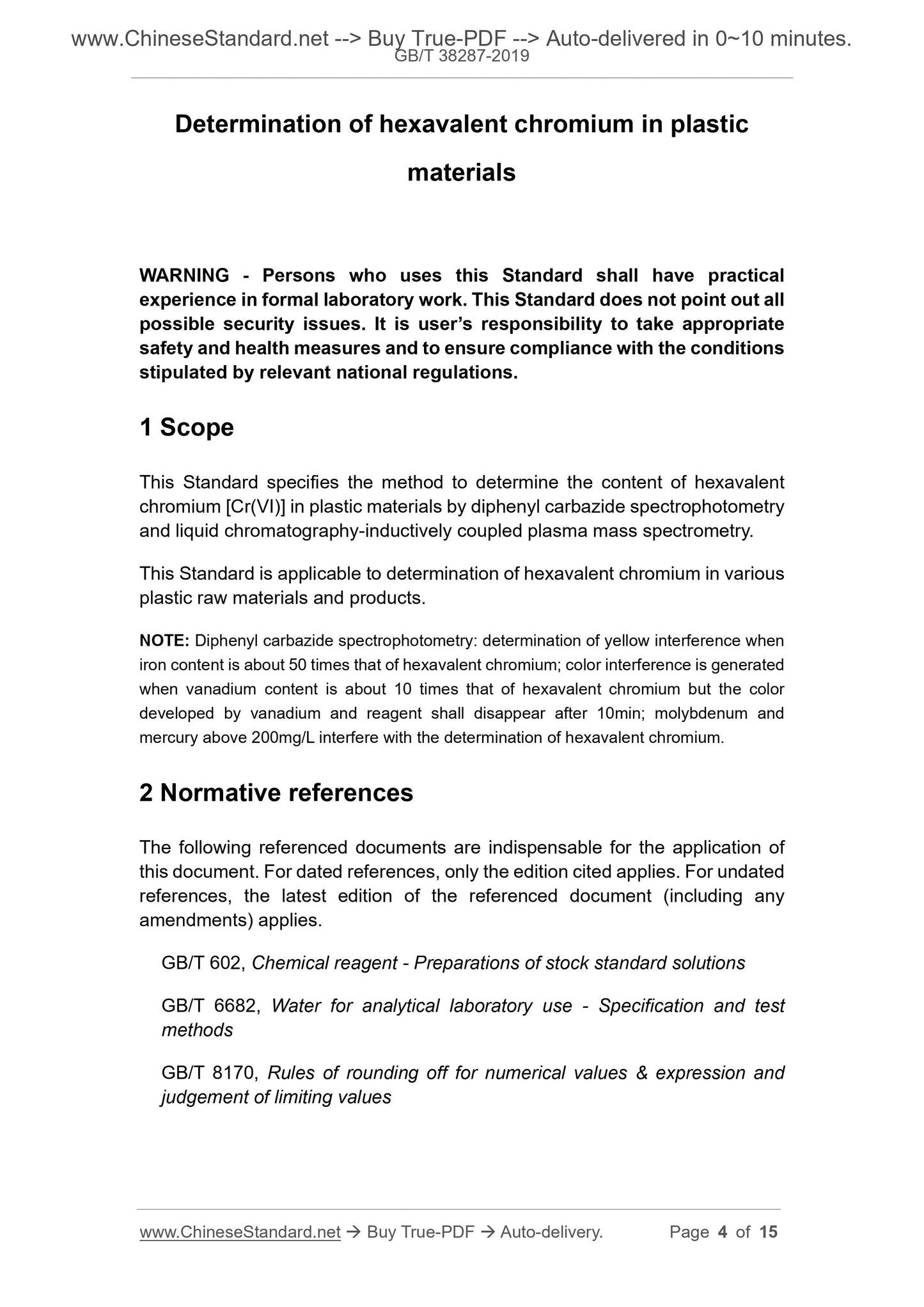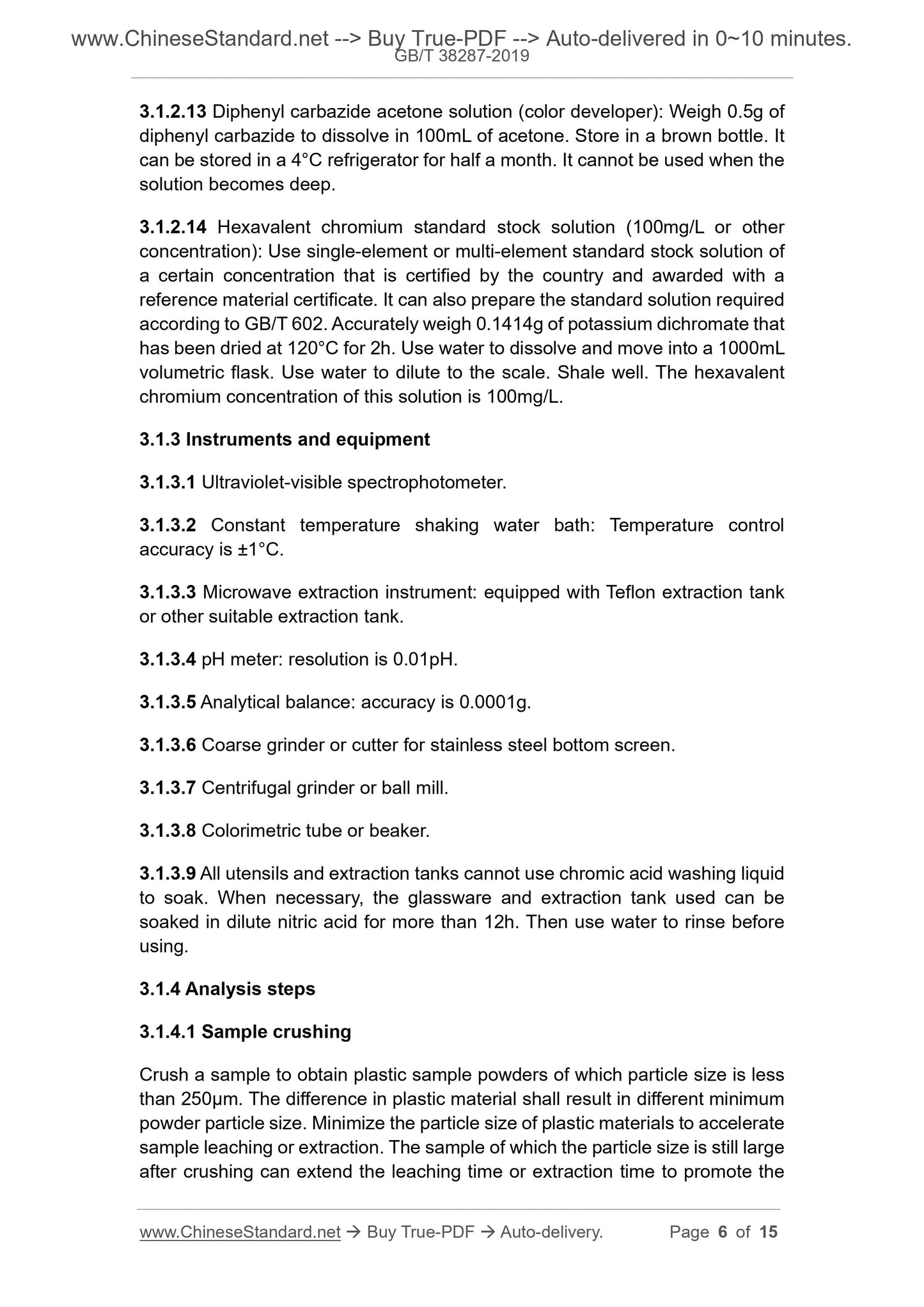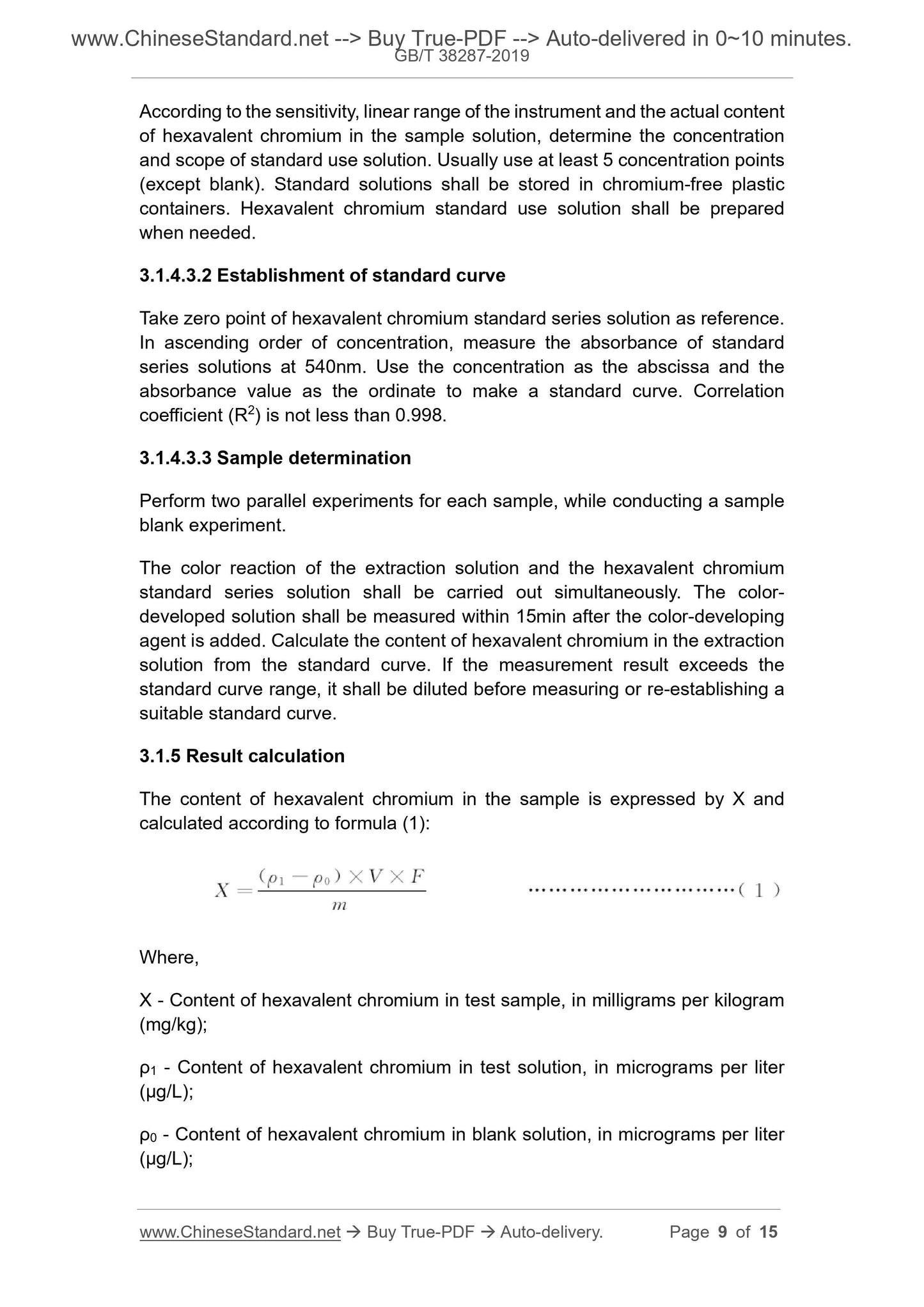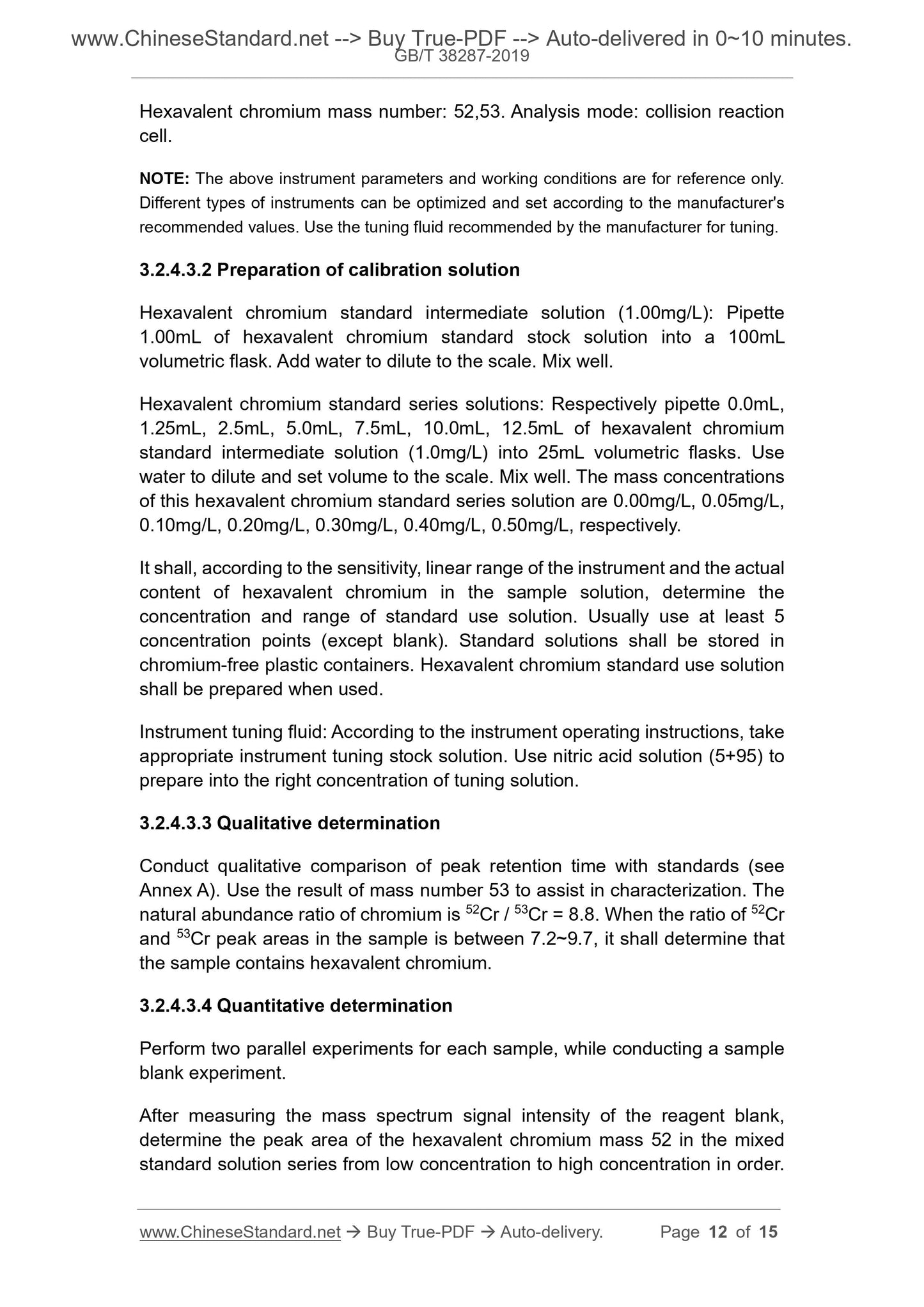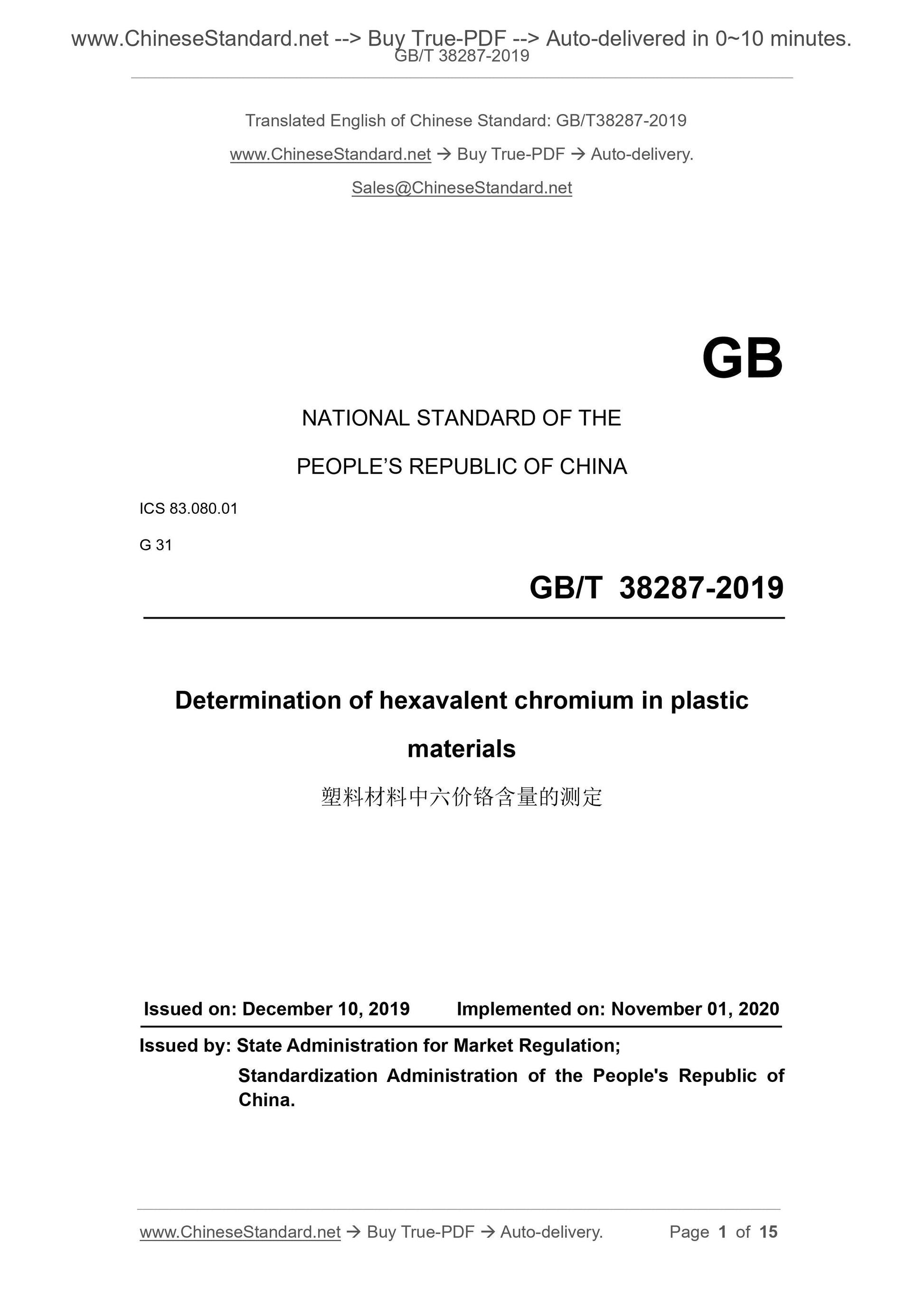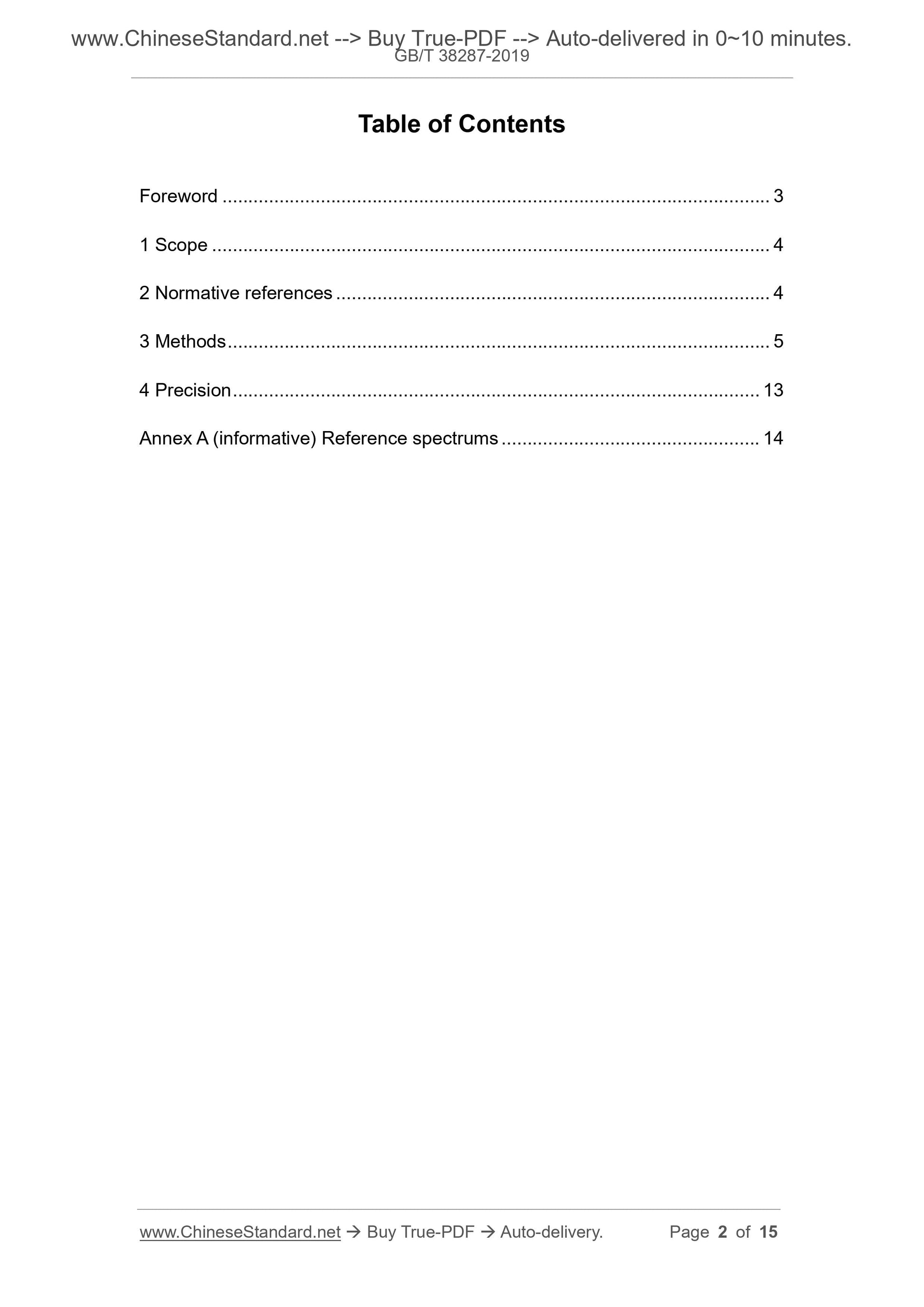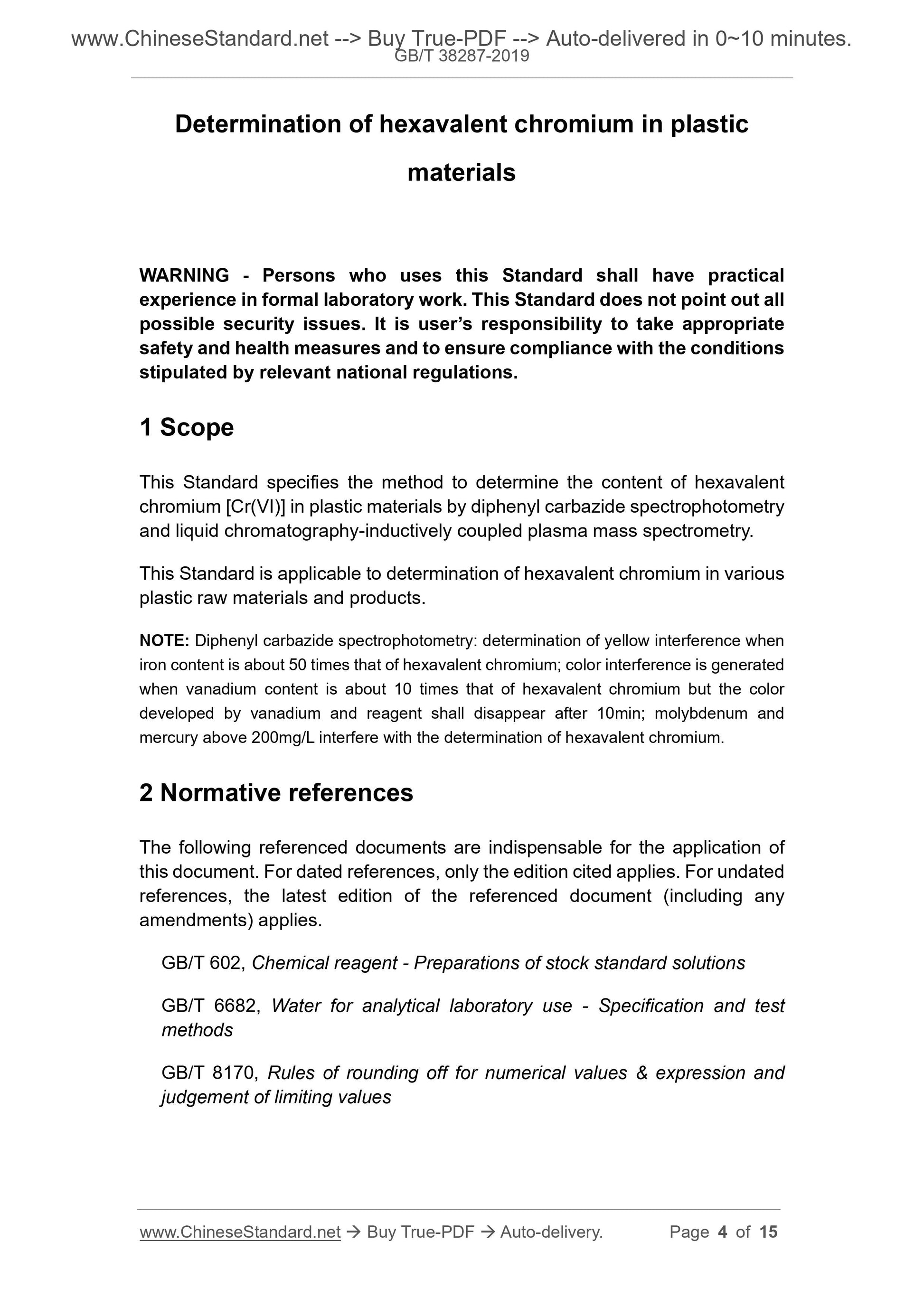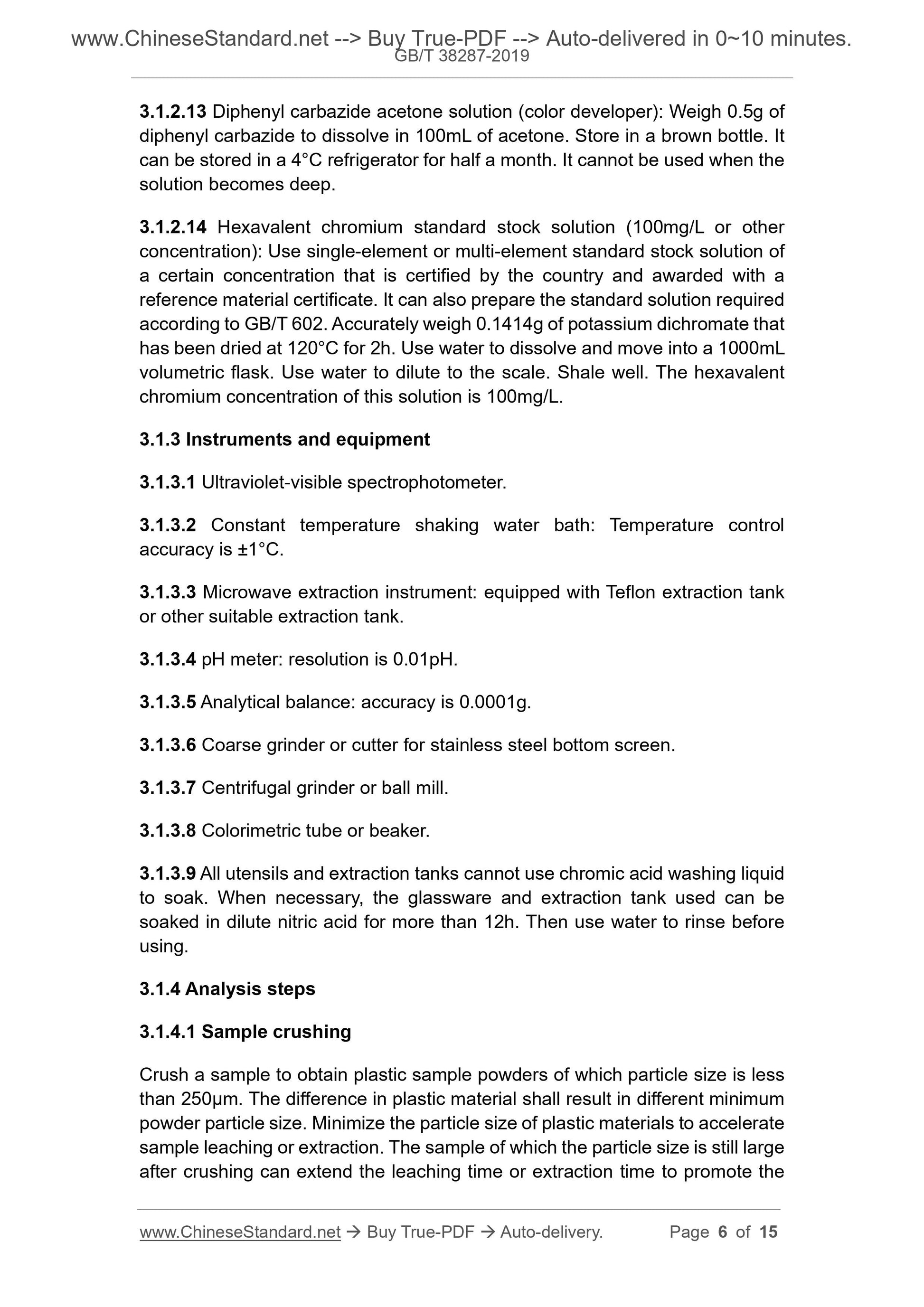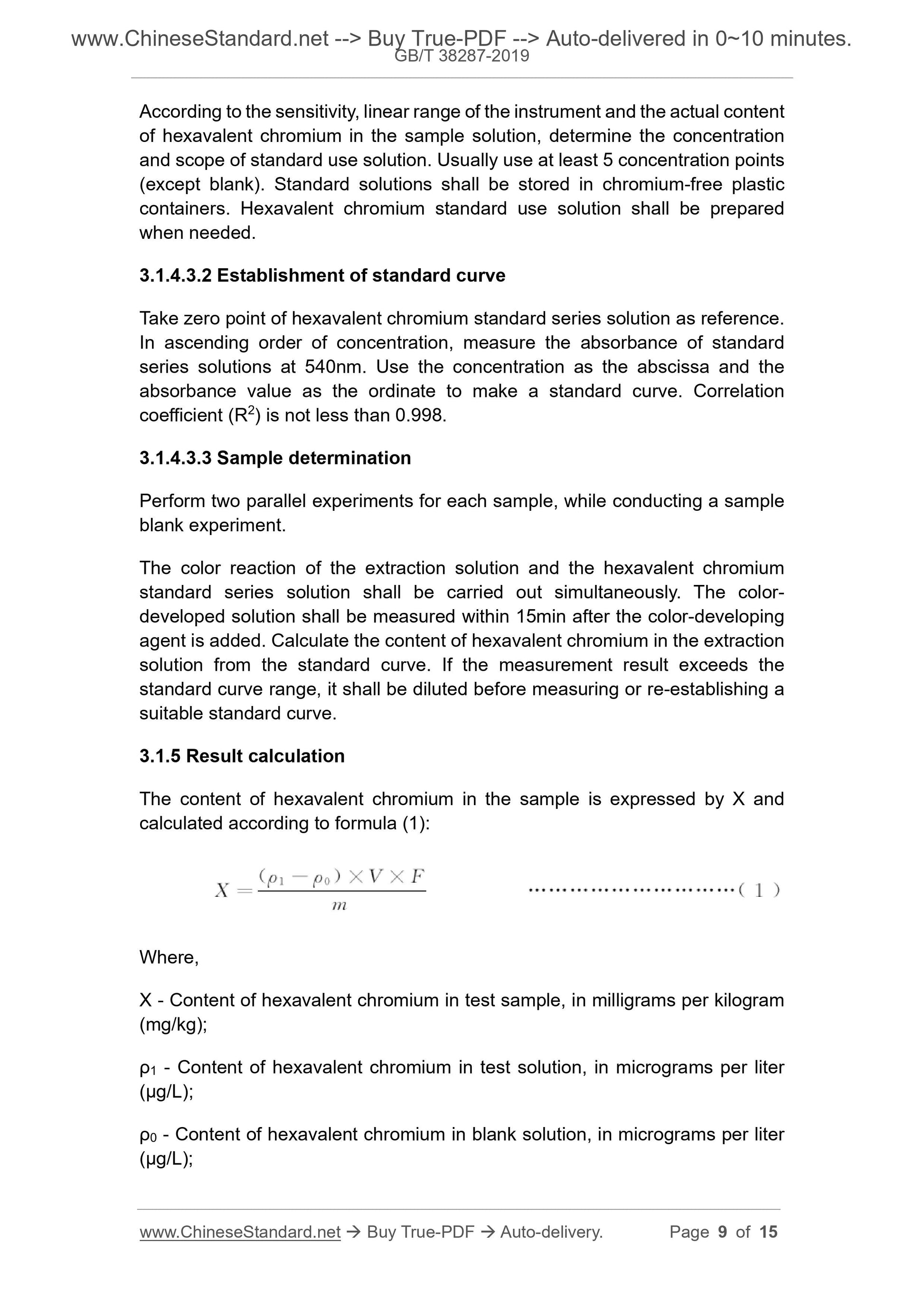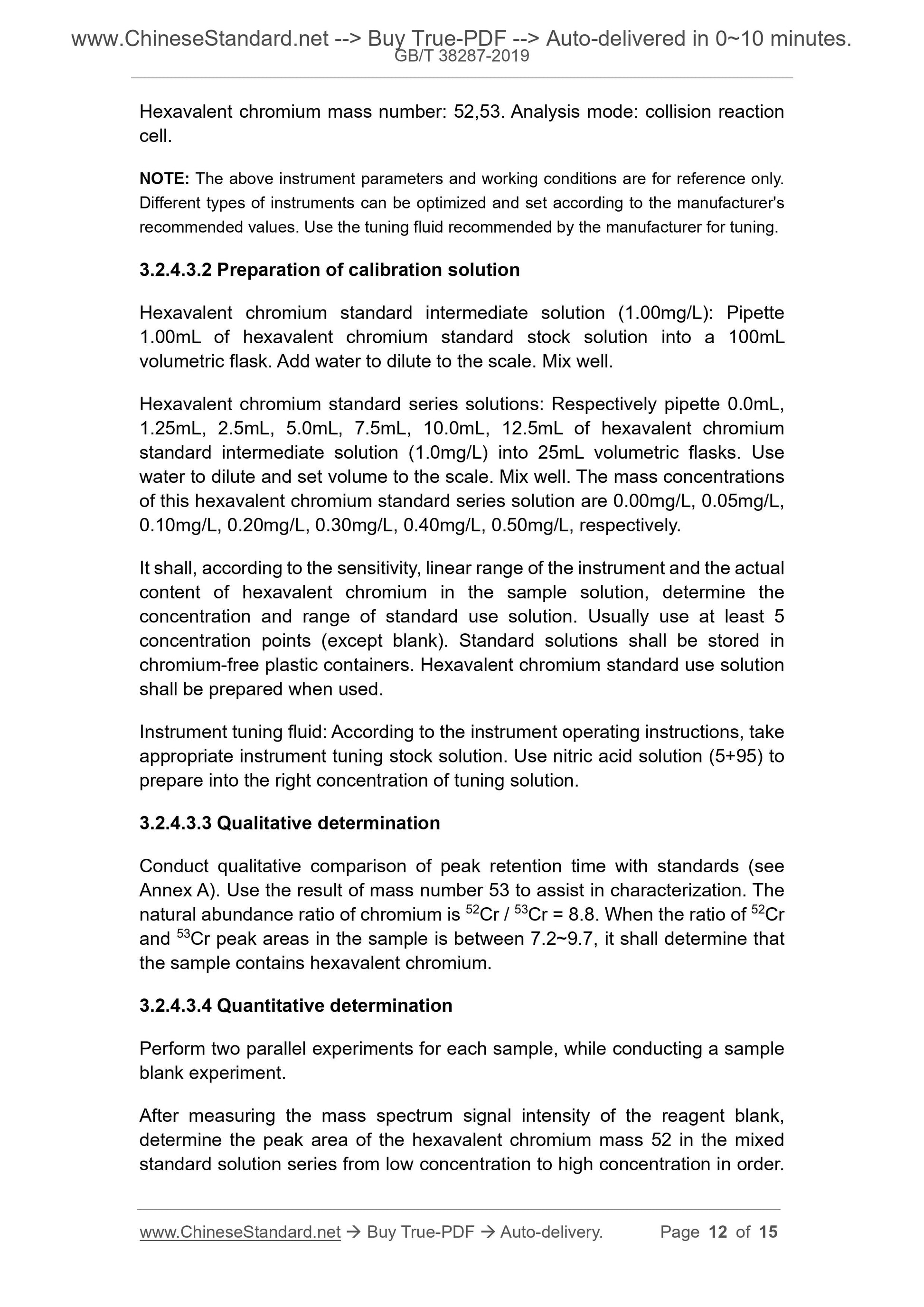1
/
von
6
PayPal, credit cards. Download editable-PDF and invoice in 1 second!
GB/T 38287-2019 English PDF (GBT38287-2019)
GB/T 38287-2019 English PDF (GBT38287-2019)
Normaler Preis
$150.00 USD
Normaler Preis
Verkaufspreis
$150.00 USD
Grundpreis
/
pro
Versand wird beim Checkout berechnet
Verfügbarkeit für Abholungen konnte nicht geladen werden
Delivery: 3 seconds. Download true-PDF + Invoice.
Get QUOTATION in 1-minute: Click GB/T 38287-2019
Historical versions: GB/T 38287-2019
Preview True-PDF (Reload/Scroll if blank)
GB/T 38287-2019: Determination of hexavalent chromium in plastic materials
GB/T 38287-2019
NATIONAL STANDARD OF THE
PEOPLE’S REPUBLIC OF CHINA
ICS 83.080.01
G 31
Determination of hexavalent chromium in plastic
materials
ISSUED ON: DECEMBER 10, 2019
IMPLEMENTED ON: NOVEMBER 01, 2020
Issued by: State Administration for Market Regulation;
Standardization Administration of the People's Republic of
China.
Table of Contents
Foreword ... 3
1 Scope ... 4
2 Normative references ... 4
3 Methods ... 5
4 Precision ... 13
Annex A (informative) Reference spectrums ... 14
Determination of hexavalent chromium in plastic
materials
WARNING - Persons who uses this Standard shall have practical
experience in formal laboratory work. This Standard does not point out all
possible security issues. It is user’s responsibility to take appropriate
safety and health measures and to ensure compliance with the conditions
stipulated by relevant national regulations.
1 Scope
This Standard specifies the method to determine the content of hexavalent
chromium [Cr(VI)] in plastic materials by diphenyl carbazide spectrophotometry
and liquid chromatography-inductively coupled plasma mass spectrometry.
This Standard is applicable to determination of hexavalent chromium in various
plastic raw materials and products.
NOTE: Diphenyl carbazide spectrophotometry: determination of yellow interference when
iron content is about 50 times that of hexavalent chromium; color interference is generated
when vanadium content is about 10 times that of hexavalent chromium but the color
developed by vanadium and reagent shall disappear after 10min; molybdenum and
mercury above 200mg/L interfere with the determination of hexavalent chromium.
2 Normative references
The following referenced documents are indispensable for the application of
this document. For dated references, only the edition cited applies. For undated
references, the latest edition of the referenced document (including any
amendments) applies.
GB/T 602, Chemical reagent - Preparations of stock standard solutions
GB/T 6682, Water for analytical laboratory use - Specification and test
methods
GB/T 8170, Rules of rounding off for numerical values and expression and
judgement of limiting values
3.1.2.13 Diphenyl carbazide acetone solution (color developer): Weigh 0.5g of
diphenyl carbazide to dissolve in 100mL of acetone. Store in a brown bottle. It
can be stored in a 4°C refrigerator for half a month. It cannot be used when the
solution becomes deep.
3.1.2.14 Hexavalent chromium standard stock solution (100mg/L or other
concentration): Use single-element or multi-element standard stock solution of
a certain concentration that is certified by the country and awarded with a
reference material certificate. It can also prepare the standard solution required
according to GB/T 602. Accurately weigh 0.1414g of potassium dichromate that
has been dried at 120°C for 2h. Use water to dissolve and move into a 1000mL
volumetric flask. Use water to dilute to the scale. Shale well. The hexavalent
chromium concentration of this solution is 100mg/L.
3.1.3 Instruments and equipment
3.1.3.1 Ultraviolet-visible spectrophotometer.
3.1.3.2 Constant temperature shaking water bath: Temperature control
accuracy is ±1°C.
3.1.3.3 Microwave extraction instrument: equipped with Teflon extraction tank
or other suitable extraction tank.
3.1.3.4 pH meter: resolution is 0.01pH.
3.1.3.5 Analytical balance: accuracy is 0.0001g.
3.1.3.6 Coarse grinder or cutter for stainless steel bottom screen.
3.1.3.7 Centrifugal grinder or ball mill.
3.1.3.8 Colorimetric tube or beaker.
3.1.3.9 All utensils and extraction tanks cannot use chromic acid washing liquid
to soak. When necessary, the glassware and extraction tank used can be
soaked in dilute nitric acid for more than 12h. Then use water to rinse before
using.
3.1.4 Analysis steps
3.1.4.1 Sample crushing
Crush a sample to obtain plastic sample powders of which particle size is less
than 250μm. The difference in plastic material shall result in different minimum
powder particle size. Minimize the particle size of plastic materials to accelerate
sample leaching or extraction. The sample of which the particle size is still large
after crushing can extend the leaching time or extraction time to promote the
According to the sensitivity, linear range of the instrument and the actual content
of hexavalent chromium in the sample solution, determine the concentration
and scope of standard use solution. Usually use at least 5 concentration points
(except blank). Standard solutions shall be stored in chromium-free plastic
containers. Hexavalent chromium standard use solution shall be prepared
when needed.
3.1.4.3.2 Establishment of standard curve
Take zero point of hexavalent chromium standard series solution as reference.
In ascending order of concentration, measure the absorbance of standard
series solutions at 540nm. Use the concentration as the abscissa and the
absorbance value as the ordinate to make a standard curve. Correlation
coefficient (R2) is not less than 0.998.
3.1.4.3.3 Sample determination
Perform two parallel experiments for each sample, while conducting a sample
blank experiment.
The color reaction of the extraction solution and the hexavalent chromium
standard series solution shall be carried out simultaneously. The color-
developed solution shall be measured within 15min after the color-developing
agent is added. Calculate the content of hexavalent chromium in the extraction
solution from the standard curve. If the measurement result exceeds the
standard curve range, it shall be diluted before measuring or re-establishing a
suitable standard curve.
3.1.5 Result calculation
The content of hexavalent chromium in the sample is expressed by X and
calculated according to formula (1):
Where,
X - Content of hexavalent chromium in test sample, in milligrams per kilogram
(mg/kg);
ρ1 - Content of hexavalent chromium in test solution, in micrograms per liter
(μg/L);
ρ0 - Content of hexavalent chromium in blank solution, in micrograms per liter
(μg/L);
Hexavalent chromium mass number: 52,53. Analysis mode: collision reaction
cell.
NOTE: The above instrument parameters and working conditions are for reference only.
Different types of instruments can be optimized and set according to the manufacturer's
recommended values. Use the tuning fluid recommended by the manufacturer for tuning.
3.2.4.3.2 Preparation of calibration solution
Hexavalent chromium standard intermediate solution (1.00mg/L): Pipette
1.00mL of hexavalent chromium standard stock solution into a 100mL
volumetric flask. Add water to dilute to the scale. Mix well.
Hexavalent chromium standard series solutions: Respectively pipette 0.0mL,
1.25mL, 2.5mL, 5.0mL, 7.5mL, 10.0mL, 12.5mL of hexavalent chromium
standard intermediate solution (1.0mg/L) into 25mL volumetric flasks. Use
water to dilute and set volume to the scale. Mix well. The mass concentrations
of this hexavalent chromium standard series solution are 0.00mg/L, 0.05mg/L,
0.10mg/L, 0.20mg/L, 0.30mg/L, 0.40mg/L, 0.50mg/L, respectively.
It shall, according to the sensitivity, linear range of the instrument and the actual
content of hexavalent chromium in the sample solution, determine the
concentration and range of standard use solution. Usually use at least 5
concentration points (except blank). Standard solutions shall be stored in
chrom...
Get QUOTATION in 1-minute: Click GB/T 38287-2019
Historical versions: GB/T 38287-2019
Preview True-PDF (Reload/Scroll if blank)
GB/T 38287-2019: Determination of hexavalent chromium in plastic materials
GB/T 38287-2019
NATIONAL STANDARD OF THE
PEOPLE’S REPUBLIC OF CHINA
ICS 83.080.01
G 31
Determination of hexavalent chromium in plastic
materials
ISSUED ON: DECEMBER 10, 2019
IMPLEMENTED ON: NOVEMBER 01, 2020
Issued by: State Administration for Market Regulation;
Standardization Administration of the People's Republic of
China.
Table of Contents
Foreword ... 3
1 Scope ... 4
2 Normative references ... 4
3 Methods ... 5
4 Precision ... 13
Annex A (informative) Reference spectrums ... 14
Determination of hexavalent chromium in plastic
materials
WARNING - Persons who uses this Standard shall have practical
experience in formal laboratory work. This Standard does not point out all
possible security issues. It is user’s responsibility to take appropriate
safety and health measures and to ensure compliance with the conditions
stipulated by relevant national regulations.
1 Scope
This Standard specifies the method to determine the content of hexavalent
chromium [Cr(VI)] in plastic materials by diphenyl carbazide spectrophotometry
and liquid chromatography-inductively coupled plasma mass spectrometry.
This Standard is applicable to determination of hexavalent chromium in various
plastic raw materials and products.
NOTE: Diphenyl carbazide spectrophotometry: determination of yellow interference when
iron content is about 50 times that of hexavalent chromium; color interference is generated
when vanadium content is about 10 times that of hexavalent chromium but the color
developed by vanadium and reagent shall disappear after 10min; molybdenum and
mercury above 200mg/L interfere with the determination of hexavalent chromium.
2 Normative references
The following referenced documents are indispensable for the application of
this document. For dated references, only the edition cited applies. For undated
references, the latest edition of the referenced document (including any
amendments) applies.
GB/T 602, Chemical reagent - Preparations of stock standard solutions
GB/T 6682, Water for analytical laboratory use - Specification and test
methods
GB/T 8170, Rules of rounding off for numerical values and expression and
judgement of limiting values
3.1.2.13 Diphenyl carbazide acetone solution (color developer): Weigh 0.5g of
diphenyl carbazide to dissolve in 100mL of acetone. Store in a brown bottle. It
can be stored in a 4°C refrigerator for half a month. It cannot be used when the
solution becomes deep.
3.1.2.14 Hexavalent chromium standard stock solution (100mg/L or other
concentration): Use single-element or multi-element standard stock solution of
a certain concentration that is certified by the country and awarded with a
reference material certificate. It can also prepare the standard solution required
according to GB/T 602. Accurately weigh 0.1414g of potassium dichromate that
has been dried at 120°C for 2h. Use water to dissolve and move into a 1000mL
volumetric flask. Use water to dilute to the scale. Shale well. The hexavalent
chromium concentration of this solution is 100mg/L.
3.1.3 Instruments and equipment
3.1.3.1 Ultraviolet-visible spectrophotometer.
3.1.3.2 Constant temperature shaking water bath: Temperature control
accuracy is ±1°C.
3.1.3.3 Microwave extraction instrument: equipped with Teflon extraction tank
or other suitable extraction tank.
3.1.3.4 pH meter: resolution is 0.01pH.
3.1.3.5 Analytical balance: accuracy is 0.0001g.
3.1.3.6 Coarse grinder or cutter for stainless steel bottom screen.
3.1.3.7 Centrifugal grinder or ball mill.
3.1.3.8 Colorimetric tube or beaker.
3.1.3.9 All utensils and extraction tanks cannot use chromic acid washing liquid
to soak. When necessary, the glassware and extraction tank used can be
soaked in dilute nitric acid for more than 12h. Then use water to rinse before
using.
3.1.4 Analysis steps
3.1.4.1 Sample crushing
Crush a sample to obtain plastic sample powders of which particle size is less
than 250μm. The difference in plastic material shall result in different minimum
powder particle size. Minimize the particle size of plastic materials to accelerate
sample leaching or extraction. The sample of which the particle size is still large
after crushing can extend the leaching time or extraction time to promote the
According to the sensitivity, linear range of the instrument and the actual content
of hexavalent chromium in the sample solution, determine the concentration
and scope of standard use solution. Usually use at least 5 concentration points
(except blank). Standard solutions shall be stored in chromium-free plastic
containers. Hexavalent chromium standard use solution shall be prepared
when needed.
3.1.4.3.2 Establishment of standard curve
Take zero point of hexavalent chromium standard series solution as reference.
In ascending order of concentration, measure the absorbance of standard
series solutions at 540nm. Use the concentration as the abscissa and the
absorbance value as the ordinate to make a standard curve. Correlation
coefficient (R2) is not less than 0.998.
3.1.4.3.3 Sample determination
Perform two parallel experiments for each sample, while conducting a sample
blank experiment.
The color reaction of the extraction solution and the hexavalent chromium
standard series solution shall be carried out simultaneously. The color-
developed solution shall be measured within 15min after the color-developing
agent is added. Calculate the content of hexavalent chromium in the extraction
solution from the standard curve. If the measurement result exceeds the
standard curve range, it shall be diluted before measuring or re-establishing a
suitable standard curve.
3.1.5 Result calculation
The content of hexavalent chromium in the sample is expressed by X and
calculated according to formula (1):
Where,
X - Content of hexavalent chromium in test sample, in milligrams per kilogram
(mg/kg);
ρ1 - Content of hexavalent chromium in test solution, in micrograms per liter
(μg/L);
ρ0 - Content of hexavalent chromium in blank solution, in micrograms per liter
(μg/L);
Hexavalent chromium mass number: 52,53. Analysis mode: collision reaction
cell.
NOTE: The above instrument parameters and working conditions are for reference only.
Different types of instruments can be optimized and set according to the manufacturer's
recommended values. Use the tuning fluid recommended by the manufacturer for tuning.
3.2.4.3.2 Preparation of calibration solution
Hexavalent chromium standard intermediate solution (1.00mg/L): Pipette
1.00mL of hexavalent chromium standard stock solution into a 100mL
volumetric flask. Add water to dilute to the scale. Mix well.
Hexavalent chromium standard series solutions: Respectively pipette 0.0mL,
1.25mL, 2.5mL, 5.0mL, 7.5mL, 10.0mL, 12.5mL of hexavalent chromium
standard intermediate solution (1.0mg/L) into 25mL volumetric flasks. Use
water to dilute and set volume to the scale. Mix well. The mass concentrations
of this hexavalent chromium standard series solution are 0.00mg/L, 0.05mg/L,
0.10mg/L, 0.20mg/L, 0.30mg/L, 0.40mg/L, 0.50mg/L, respectively.
It shall, according to the sensitivity, linear range of the instrument and the actual
content of hexavalent chromium in the sample solution, determine the
concentration and range of standard use solution. Usually use at least 5
concentration points (except blank). Standard solutions shall be stored in
chrom...
Share
